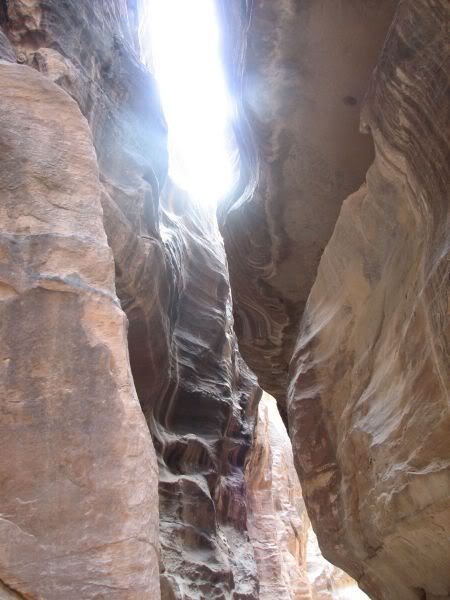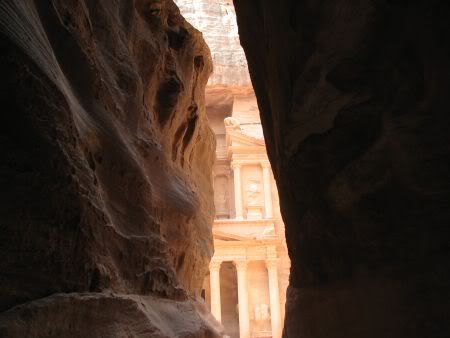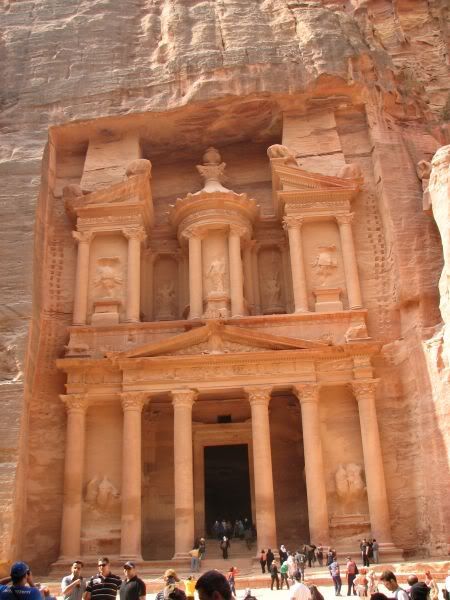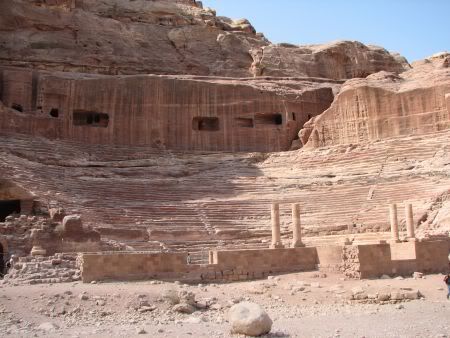In Jordan - the ancient city of Petra

we spent the day on friday (friday and saturday constitute the weekend in islamic countries) in petra, an astonishing archaeological treasure, a large city cut into utah-like sandstone canyons and crevasses, that dates back over 2400 years... you probably remember the famous scene in one of the indiana jones movies that featured the facade of one of the largest, most ornate, and impressive tombs... well, the reality of it is beyond words... unfortunately, not only were there piles of tourists, but nearby they were also filming the next transformers movie (Transformers: Revenge of the Fallen), imho, unforgiveable tackiness in a place like that...
in any case, here is just a sampling of the many, many photos i took on friday...

Walking through the Siq

Petra Treasury seen from the Siq


The Petra amphitheatre
Petra
Petra (from "petra", rock in Greek; Arabic: البتراء, Al-Batrāʾ) is an archaeological site in the Arabah, Ma'an Governorate, Jordan, lying on the slope of Mount Hor in a basin among the mountains which form the eastern flank of Arabah (Wadi Araba), the large valley running from the Dead Sea to the Gulf of Aqaba. It is renowned for its rock-cut architecture. Petra is also one of the new wonders of the world.
The site remained unknown to the Western world until 1812, when it was discovered by Swiss explorer Johann Ludwig Burckhardt. It was famously described as "a rose-red city half as old as time" in a Newdigate prize-winning sonnet by John William Burgon. UNESCO has described it as "one of the most precious cultural properties of man's cultural heritage." In 1985, Petra was designated a UNESCO World Heritage Site.
Rekem is an ancient name for Petra and appears in Dead Sea scrolls associated with Mount Seir. Additionally, Eusebius and Jerome assert that Rekem was the native name of Petra, supposedly on the authority of Josephus. Pliny the Elder and other writers identify Petra as the capital of the Nabataeans, Aramaic-speaking Semites, and the centre of their caravan trade. Enclosed by towering rocks and watered by a perennial stream, Petra not only possessed the advantages of a fortress but controlled the main commercial routes which passed through it to Gaza in the west, to Bosra and Damascus in the north, to Aqaba and Leuce Come on the Red Sea, and across the desert to the Persian Gulf.
Excavations have demonstrated that it was the ability of the Nabataeans to control the water supply that led to the rise of the desert city, in effect creating an artificial oasis. The area is visited by flash floods and archaeological evidence demonstrates the Nabataeans controlled these floods by the use of dams, cisterns and water conduits. These innovations stored water for prolonged periods of drought, and enabled the city to prosper from its sale.
[...]
Although in ancient times Petra might have been approached from the south (via Saudi Arabia on a track leading around Jabal Haroun, Aaron's Mountain, on across the plain of Petra), or possibly from the high plateau to the north, most modern visitors approach the ancient site from the east. The impressive eastern entrance leads steeply down through a dark, narrow gorge (in places only 3–4 metres wide) called the Siq ("the shaft"), a natural geological feature formed from a deep split in the sandstone rocks and serving as a waterway flowing into Wadi Musa. At the end of the narrow gorge stands Petra's most elaborate ruin, Al Khazneh ("the Treasury"), hewn into the sandstone cliff.
The Monastery at Petra
A little further from the Treasury, at the foot of the mountain called en-Nejr is a massive theatre, so placed as to bring the greatest number of tombs within view. At the point where the valley opens out into the plain, the site of the city is revealed with striking effect. The amphitheatre has actually been cut into the hillside and into several of the tombs during its construction. Rectangular gaps in the seating are still visible. Almost enclosing it on three sides are rose-colored mountain walls, divided into groups by deep fissures, and lined with knobs cut from the rock in the form of towers.
and, if petra wasn't amazing enough, we went from there to wadi rum, but i will dedicate a separate post to that equally astonishing area...
Labels: Aqaba, Jordan, Petra, photoblogging, Wadi Rum
Submit To PropellerTweet














